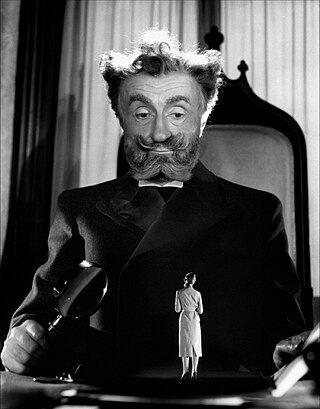A film crew is a group of people, hired by a production company, for the purpose of producing a film or motion picture. The crew is distinguished from the cast, as the cast are understood to be the actors who appear in front of the camera or provide voices for characters in the film. The crew is also separate from the producers, as the producers are the ones who own a portion of either the film studio or the film's intellectual property rights. A film crew is divided into different departments, each of which specializes in a specific aspect of the production. Film crew positions have evolved over the years, spurred by technological change, but many traditional jobs date from the early 20th century and are common across jurisdictions and filmmaking cultures.

Special effects are illusions or visual tricks used in the theatre, film, television, video game, amusement park and simulator industries to simulate the fictional events in a story or virtual world. It is sometimes abbreviated as SFX, but this may also refer to sound effects.
Visual effects is the process by which imagery is created or manipulated outside the context of a live-action shot in filmmaking and video production. The integration of live-action footage and other live-action footage or CGI elements to create realistic imagery is called VFX.
A technical director (TD) is usually a senior technical person within e.g. a software company, engineering firm, film studio, theatre company or television studio. This person usually has the highest level of skill within a specific technical field.

Houdini is a 3D animation software application developed by Toronto-based SideFX, who adapted it from the PRISMS suite of procedural generation software tools.

A matte painting is a painted representation of a landscape, set, or distant location that allows filmmakers to create the illusion of an environment that is not present at the filming location. Historically, matte painters and film technicians have used various techniques to combine a matte-painted image with live-action footage (compositing). At its best, depending on the skill levels of the artists and technicians, the effect is seamless and creates environments that would otherwise be impossible or expensive to film. In the scenes, the painting part is static while movements are integrated on it.

Autodesk Softimage is a discontinued 3D computer graphics application, for producing 3D computer graphics, 3D modeling, and computer animation. Now owned by Autodesk and formerly titled Softimage XSI, the software has been predominantly used in the film, video game, and advertising industries for creating computer generated characters, objects, and environments.

Karen Ansel is a visual effects specialist in the United States.

Graphic art software is a subclass of application software used for graphic design, multimedia development, stylized image development, technical illustration, general image editing, or simply to access graphic files. Art software uses either raster or vector graphic reading and editing methods to create, edit, and view art.

Virtual cinematography is the set of cinematographic techniques performed in a computer graphics environment. It includes a wide variety of subjects like photographing real objects, often with stereo or multi-camera setup, for the purpose of recreating them as three-dimensional objects and algorithms for the automated creation of real and simulated camera angles. Virtual cinematography can be used to shoot scenes from otherwise impossible camera angles, create the photography of animated films, and manipulate the appearance of computer-generated effects.
Previsualization is the visualizing of scenes or sequences in a movie before filming. It is a concept used in other creative arts, including animation, performing arts, video game design, and still photography. Previsualization typically describes techniques like storyboarding, which uses hand-drawn or digitally-assisted sketches to plan or conceptualize movie scenes.
In the context of film and television production, a visual effects supervisor is responsible for achieving the creative aims of the director or producers through the use of visual effects.
A graphics coordinator (GC) or font assist is an individual who works, usually on a television show, as a producer of on-air still and motion graphics. The graphics coordinator decides what content should be displayed on-air — such as on a fullpage or a lower third. The GC should not be confused with the Operator, who usually operates a character generator (CG) and is part of a television crew, or a broadcast designer who physically creates the graphics.

Craig Barron is an American visual effects artist and creative director at Magnopus, a media company that produces visual development and virtual production services for motion pictures, television, museums and multimedia platforms.
Matte World Digital was a visual effects company based in Novato, California that specialized in realistic matte painting effects and digital environments for feature films, television, electronic games and IMAX large-format productions. The company closed in 2012 after 24 years of service in the entertainment industry.

Method Studios is a visual effects company launched in 1999 in Los Angeles, California with facilities in New York, Atlanta, Vancouver, San Francisco, Melbourne, Montreal, and Pune. The company provides production and post-production services including conceptual design, look development, on-set supervision, 3D animation/CGI, matte painting, AR/VR, compositing and finishing.
Makuta is an Indian visual effects and animation company based in Santa Clara, CA with branches in Hyderabad, India and Universal City, CA. The company received the prestigious National Film Award for Best Special Effects, from the Indian government, in 2010 and 2012, for Magadheera and Eega, respectively.
Efraim "Effi" Wizen is an Israeli computer animator and visual effects specialist.

Allan McKay is a Los-Angeles based visual effects supervisor and technical director. He is responsible for visual effects sequences in projects including Transformers: Dark of the Moon, Blade, The Last Airbender, Star Trek: Into Darkness, Flight, The Equalizer, and other films. He has also worked on several video games including Halo, Destiny, Call of Duty, Bioshock, Prototype, Half-Life, Team Fortress 2, and others.







